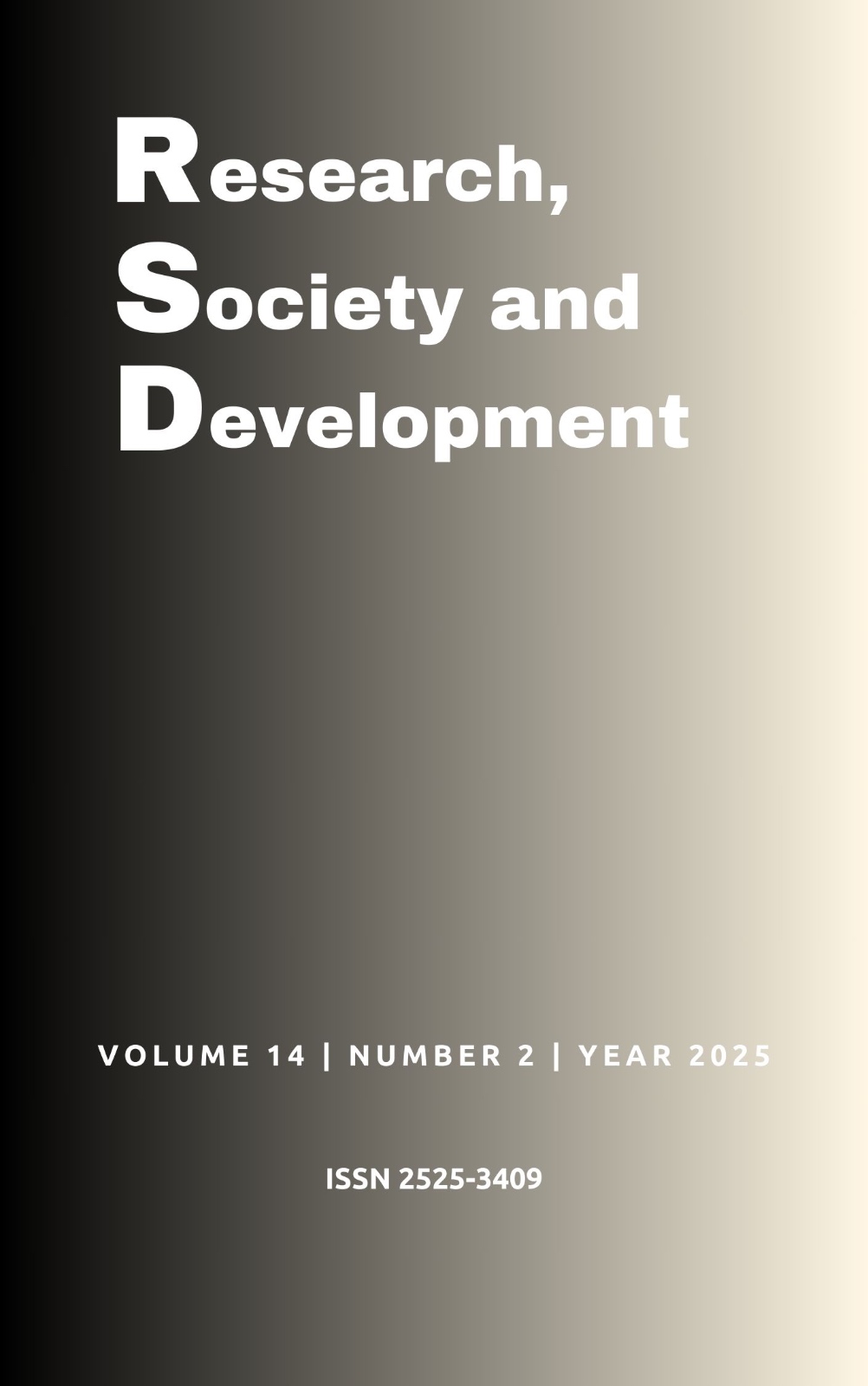Factors that support the high prevalence of tuberculosis in the northern region of Brazil: An epidemiological analysis from 2015 to 2020
DOI:
https://doi.org/10.33448/rsd-v14i2.48279Keywords:
Tuberculosis, Epidemiological profile, Mycobacterium tuberculosis.Abstract
Tuberculosis (TB) is an infection caused by the bacteria Mycobacterium tuberculosis, which mainly affects the lungs and is transmitted through oral secretions. The disease, although often asymptomatic, is indicated by a persistent cough. Historically, TB dates back to ancient civilizations and arrived in Brazil with colonization. The disease continues to be one of the main causes of death from bacterial infections in the world and its situation has been worsened by the COVID-19 pandemic and social vulnerability. The research aimed to analyze factors that support the high prevalence of tuberculosis in the northern region of Brazil. The study in the North of Brazil analyzed TB records from 2015 to 2020, using data from DataSUS. The research was quantitative and identified factors such as diabetes, smoking, alcoholism and age group, correlating them with the prevalence of the disease. It was shown that Brazil registered 540,370 cases, with 2019 standing out for the highest number of infections. In the North region, Pará had the highest number of cases, while Amazonas had the highest prevalence rate. Factors such as smoking and alcoholism were shown to be the main risks for the development of TB, with a higher incidence among men and people aged 25 to 34 years. The study reinforces the high prevalence of the disease in the North region and the urgent need for control and prevention measures, highlighting tuberculosis as a serious public health problem in Brazil.
Downloads
References
Alves Filho, J. R et al. (2017). Desigualdades socioespaciais relacionadas à tuberculose no município de Itaboraí, Rio de Janeiro. Revista Brasileira de Epidemiologia. 20(4), 559–72.
Banner, A. S. (1973). Pulmonary function in chronic alcoholism. Amer. Rev. resp. Dis. 108, 851-7.
Becker, F. G. & Cleary, M. (2015). Team RM, Holtermann H, The D, Agenda N, et al. Syria Studies. 7, 37-72.
Brasil. (2020). Portaria MS n 1061, de 18-05-2020. Consolidação das normas sobre os sistemas e os subsistemas do Sistema Único de Saúde.
Brasil (2017). Ministério da Saúde. Guia de Vigilância em Saúde. Vol 2. Brasília: Ministério da Saúde. Secretaria de Vigilância em Saúde. Coordenação Geral de Desenvolvimento da Epidemiologia em Serviços.
Brasil. (2016). Sistema de Informação de Agravos de Notificação (SINAN): Tuberculose. Ministério da Saúde. Secretaria de Vigilância em Saúde. Departamento de Informática do SUS (DATASUS). Brasília: DATASUS; 2016
Brasil. (2015). Indicadores Regionais, Estaduais e Nacionais do Rol de Diretrizes, Objetivos, Metas e Indicadores 2015. Ministério da Saúde. Secretaria de Vigilância em Saúde. Departamento de Informática do SUS (DATASUS). Brasília: DATASUS http://tabnet.datasus.gov.br/cgi/deftohtm.exe?pacto/2015/cnv/coapcirbr.def.
Brasil. (2009). III Diretrizes para Tuberculose da Sociedade Brasileira de Pneumologia e Tisiologia. Jornal Brasileiro de Pneumologia. Brasília: Sociedade Brasileira de Pneumologia e Tisiologia. Ministério da Saúde (Org.). p. 1018-1048.
Brasil. (2020). Situação de saúde e indicadores de morbidade da tuberculose. Brasília: Ministério da Saúde.
Maciel, M. D. S. et al. (2012). A história da tuberculose no Brasil: os muitos tons (de cinza) da miséria. Rev Bras Clínica Médica. 10(3), 226–30.
Mocelin, L.C. & Zanella, J.D.F.P. (2019). Tuberculose pulmonar: aspectos clínicos, diagnóstico e tratamento. XXIV Seminário Interinstitucional de Ensino, Pesquisa e Extensão.
Muñoz-Sánchez, A.I, Rubiano-Mesa, Y.L. & Saavedra-Cantor, C.J. (2020). Measuring instrument: Knowledge, attitudes and practices of people with pulmonary tuberculosis. Rev Lat Am Enfermagem. 27, e3086.
Nogueira, A. et al. (2012). Tuberculose: uma abordagem geral dos principais aspectos. Rev Bras Farm. 93(1), 3–9.
Pereira A. S. et al. (2018). Metodologia da pesquisa científica. [free e-book]. Editora UAB/NTE/UFSM.
Queiroz, M. C., Ferreira, K. R. & Bertolozzi, M. R. (2012). Tuberculose: Limites e potencialidades do tratamento supervisionado. Rev Lat Am Enfermagem. 20(2), 369–77.
Shitsuka, R. et al. (2014). Matemática fundamental para tecnologia. (2a ed.). Editora Erica.
Silva, D. R. et al. (2020). Tuberculosis series 2020. J Bras Pneumol, 2(46), 1-2.
Silva, P. H. C. (2020). Análise Comparativa do Perfil Epidemiológico da Tuberculose no estado do Tocantins e Região Norte do Brasil entre 2009 e 2019. Revista de Patologia do Tocantins. 7(1), 3-9.
Silva, D. R. et al. (2021). Consenso sobre o diagnóstico da tuberculose da Sociedade Brasileira de Pneumologia e Tisiologia. Jornal Brasileiro de Pneumologia. 47(2), e20210054. 10.36416/1806-3756/e20210054.
Silva, P. D. B. (2017). Tuberculose no Tocantins: Perfil epidemiológico dos casos de retratamento e fatores associados à recidiva e ao abandono. (Dissertação de Mestrado em Saúde Coletiva com Área em Concentração e Epidemiologia em Serviços da Saúde com Ênfase em Vigilância da Saúde). Salvador, UFBA.
Souza, S. S., Silva, D. M. G. V. & Meirelles, B. H. S. (2010). Representações sociais sobre a tuberculose. Acta Paulista de Enfermagem. 23, 23-8.
Toassi, R. F. C. & Petry, P. C. (2021). Metodologia científica aplicada à área da Saúde. (2a ed.). Editora da UFRGS
WHO. (2020). Global tuberculosis report 2018. Geneva: World Health Organization (WHO).
Downloads
Published
Issue
Section
License
Copyright (c) 2025 Eduardo Chaves Ferreira Coelho; Carlos Eduardo Macedo Rego; Jailson Antônio da Luz Júnior; Brenda de Oliveira Melo; Ana Beatriz Ferro de Melo; Pedro Gabriel de Lima Carneiro Borges; Edna Joana Claudio Manrique

This work is licensed under a Creative Commons Attribution 4.0 International License.
Authors who publish with this journal agree to the following terms:
1) Authors retain copyright and grant the journal right of first publication with the work simultaneously licensed under a Creative Commons Attribution License that allows others to share the work with an acknowledgement of the work's authorship and initial publication in this journal.
2) Authors are able to enter into separate, additional contractual arrangements for the non-exclusive distribution of the journal's published version of the work (e.g., post it to an institutional repository or publish it in a book), with an acknowledgement of its initial publication in this journal.
3) Authors are permitted and encouraged to post their work online (e.g., in institutional repositories or on their website) prior to and during the submission process, as it can lead to productive exchanges, as well as earlier and greater citation of published work.


